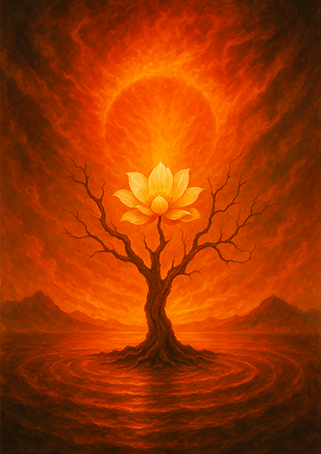Xieyi・The Rootless Tree:100 Verses-Verse 47#501

The poems of “The Rootless Tree” express a fundamental force rooted in harmony with heaven and earth, the cyclical flow of yin and yang, and the infinite potential of existence。
This painting is an expressive “Xieyi” in the tradition of “futu” (spiritual diagrams), passed down for generations in Wudang Mountain, China. It is drawn through a technique where energy flow (xingqi) channels the internal intention into visual form。 In the Taoist world, there exist spiritual and symbolic images called “futu”。
In the Taoist world, there exist spiritual and symbolic images called “futu”。
These are a type of talisman—not merely religious items, but expressive spiritual paintings that act directly on the mind of the viewer。
Since ancient times, many people have placed these Taoist-style “Xieyi” and futu in their homes, studies, or bedrooms, wishing for longevity, health, auspiciousness, and family harmony. Viewing such paintings was not just aesthetic appreciation, but an act of inviting the presence of the Dao into one’s life and tuning the body and mind。
Thus, “Xieyi” is more than artistic expression—it is a medium that bridges the spirit, life, and harmony with the universe。
This kind of artwork is not meant to be seen only with the eyes, but felt with the heart。
It communicates with the Dao, resonates with the qi of nature, and quietly stirs the viewer’s inner self。
Futu and “Xieyi” continue to live on from ancient times to this day as “sacred images that speak to the soul.”
Below, we present the original text of the philosophical poem “The Rootless Tree,” along with a modern Japanese translation and interpretation。
※ The author of “The Rootless Tree,” Zhang Sanfeng (1247–?), is also renowned as the founder of Tai Chi, and it is said that he applied the essence of this work to Tai Chi. As an additional note, we include an interpretation connecting this to the Tai Chi tradition of Wudang Mountain.
The Rootless Tree・Verse 47

▶Original Text
無根樹,花正南,火焰煉心,光明照道。氣升如炎,神融無礙,真如不動,行者自安。
▶Modern Translation
Southward, a blossom faces the sun on the rootless tree;
Fire refines the heart, its light reveals the Way.
Qi rises like flame, spirit blends without barrier;
Truth stands unmoved, and the adept rests therein.
▶Interpretation
1.[無根樹,花正南] South/fire/heart—mature passion.
2.[火焰煉心,光明照道] Intense heat tempers mind and illumines path.
3.[氣升如炎,神融無礙] Ascending qi, seamless spiritual fusion.
4.[真如不動,行者自安] Unshakable reality grants inner peace.
▶Interpretation related to Tai Chi
•Inner heat of advanced nei-gong.
•Radiant shen guides movement.
•Unified jing-qi-shen lifts energy upward.
•Stability amid fiery expression.
Copyright © MASAKI WAKABAYASHI. All rights reserved.




